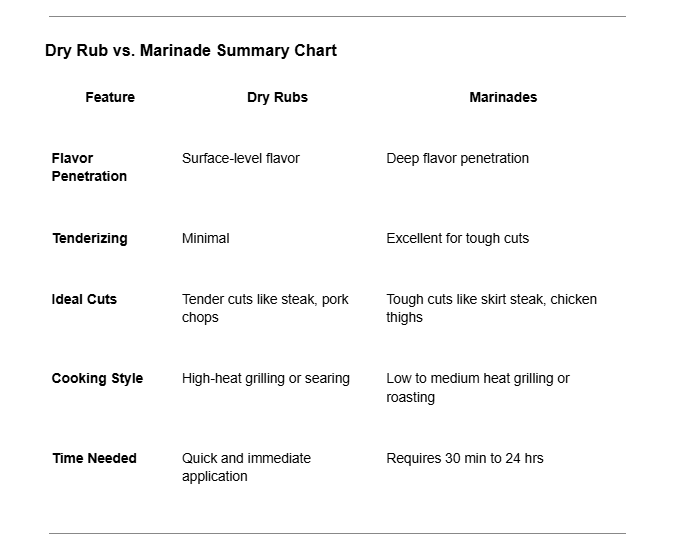Dry Rubs vs. Wet Marinades: When to Use Each for Perfect BBQ Flavor
When it comes to grilling and BBQ, one of the biggest decisions is whether to use a dry rub or a wet marinade. Both techniques can add incredible flavor to your meats, but each has unique benefits and works best in different situations. In this guide, we’ll break down the differences between dry rubs and wet marinades, when to use each, and how to get the most out of these flavorful techniques.
What is a Dry Rub?
A dry rub is a blend of spices, herbs, and seasonings that’s applied directly to the surface of the meat. Dry rubs create a crust on the outside of the meat, enhancing flavor, texture, and appearance. Some popular ingredients in dry rubs include salt, pepper, paprika, brown sugar, garlic powder, and chili powder.
Pros of a Dry Rub:
Adds Texture and Bark: Dry rubs form a crust that enhances texture, especially for BBQ ribs, brisket, and steaks.
No Waiting Time: Unlike marinades, dry rubs can be applied immediately before cooking, so they’re ideal for quick grilling sessions.
Ideal for High Heat: Dry rubs are less likely to burn than marinades, making them perfect for high-heat grilling and searing.
Cons of a Dry Rub:
Less Tenderizing: Dry rubs won’t tenderize meat as much as marinades, so they’re best for already tender cuts.
Less Penetration of Flavor: Dry rubs mainly season the surface of the meat rather than penetrating deep inside.
When to Use a Dry Rub
For Quick Grilling: If you’re cooking meat quickly on a grill, like burgers, steaks, or chicken wings, a dry rub adds great surface flavor and texture without needing to marinate for hours.
With Already Tender Cuts: Dry rubs work best on tender cuts like chicken breasts, pork chops, steaks, or ribs. They don’t need the tenderizing effects of a marinade, so a rub helps to boost flavor without altering the texture.
When You Want a Crust or Bark: For slow-smoked BBQ, like ribs or brisket, a dry rub is ideal for creating a tasty bark, which adds to the meat’s texture and flavor.
What is a Wet Marinade?
A marinade is a liquid mixture that includes an acidic component (such as vinegar, citrus juice, or yogurt), oil, and seasonings. Marinades are typically used to flavor meat and to tenderize tougher cuts. By letting the meat soak in the marinade, the flavors penetrate deeper, and the acidic ingredients help break down muscle fibers.
Pros of a Marinade:
Tenderizes Tough Cuts: Marinades are ideal for tougher cuts like skirt steak, flank steak, or chicken thighs that benefit from tenderizing.
Infuses Deep Flavor: Because they’re liquid, marinades penetrate deeper into the meat, adding more flavor throughout.
Great for Slow-Cooking: Marinades work well for meats cooked slowly over lower heat, like roasting or grilling at medium heat.
Cons of a Marinade:
Needs More Time: Marinades often require several hours to effectively flavor and tenderize the meat, so they’re not ideal for last-minute grilling.
Can Burn at High Heat: Marinades with sugar can burn when exposed to high heat, so they’re better for low or medium heat cooking.
When to Use a Marinade
For Tough Cuts of Meat: Marinades are ideal for cuts that need tenderizing, such as flank steak, skirt steak, pork shoulder, or tougher cuts of chicken. The acid helps to break down tough fibers, making the meat more tender.
When You Have Time: Marinades work best when meat soaks for at least 30 minutes to a few hours. For a deeper flavor, plan to marinate overnight.
With Low to Medium Heat Cooking: If you’re cooking meat over moderate heat (300°F to 350°F), like roasting or indirect grilling, marinades are a great choice. This allows the sugars to caramelize slowly without burning.
When to Use Both: Layering Marinades and Rubs
In some cases, you can layer both a marinade and a dry rub for the best of both worlds. For example, marinate the meat to infuse flavor and tenderize, then apply a dry rub just before grilling to create a flavorful crust. Just be sure to pat the meat dry before applying the rub to prevent steaming instead of searing.
Example Combination:
Marinate a pork shoulder in apple cider vinegar, salt, and brown sugar overnight.
Before grilling, pat dry and apply a dry rub with paprika, garlic powder, salt, and pepper for a flavorful crust.
Final Thoughts
Choosing between a dry rub and a marinade depends on the type of meat, your cooking method, and the flavors you want to achieve. For high-heat grilling and quick cooks, go for a dry rub to build a savory crust. If you’re working with tougher cuts or want deep, infused flavor, opt for a marinade.
Experiment with both methods, try different flavor combinations, and find what works best for your BBQ style. Whether you’re team dry rub or team marinade, there’s no wrong way to add flavor to your BBQ!
Happy Grilling!

